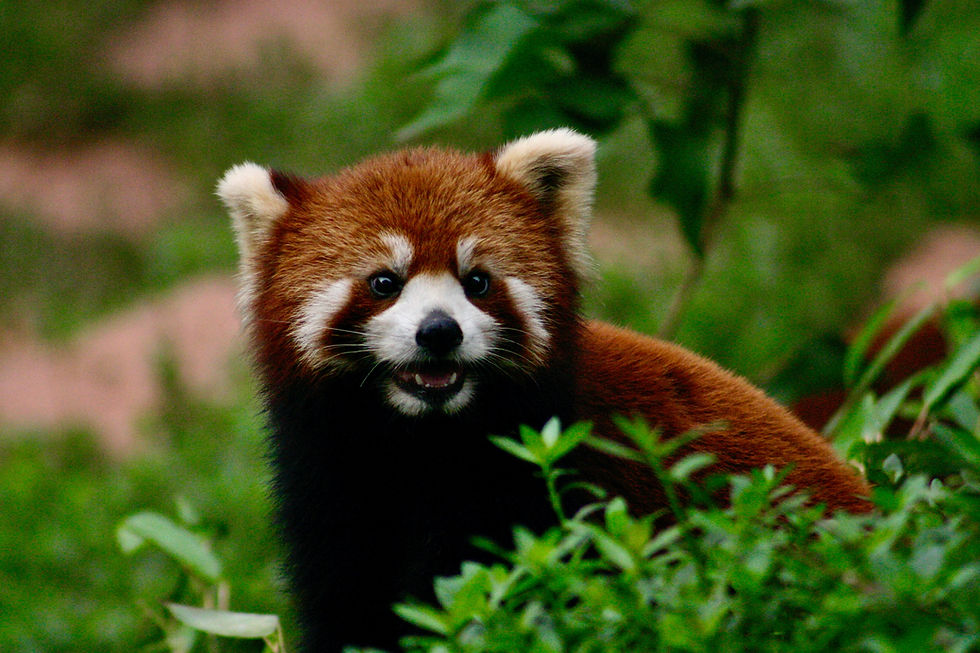Red Panda
- jessiekdesign
- Jan 23, 2023
- 4 min read

Red pandas are native to the eastern Himalayas and southwestern China. They prefer to live in temperate and bamboo forests at elevations of 2,200 to 4,800 meters. Red pandas have a solitary lifestyle, and they usually only come together during the mating season. They are active during the night, and spend most of the day sleeping in trees or dens. They are also known to mark their territories with urine and secretions from their glands.
Red pandas are also known to communicate with each other through vocalizations, such as bleats and whistles, as well as through scent marking.

Red pandas have a polygynous mating system, which means that males will mate with multiple females. Mating season is typically in the late winter, and females will give birth to one to four cubs in the early summer. Red panda cubs are born very small and helpless. They typically weigh around 100-150 grams (about the size of a stick of butter) at birth and are born blind, with their eyes closed. They are also completely covered in soft, woolly fur, which helps keep them warm.
They will stay with their mother for about a year before they are able to survive on their own. During this time, the mother will teach them how to find food, climb trees, and avoid predators. The cubs will also nurse from their mother for several months before they start to eat solid food.

Red pandas are considered a "flagship species" for the conservation of the bamboo forests that they inhabit. Their population is currently declining due to habitat loss caused by human activities such as logging and agriculture, as well as poaching.
A flagship species is a species that is used as a symbol or representative of a particular conservation campaign or project. These species are often chosen because they are easily recognizable, have a high public profile, or are an indicator of the health of an ecosystem.
The idea behind using a flagship species is that by protecting that species and its habitat, many other species and their habitats will also be protected. By focusing on a single, charismatic species, conservationists can raise public awareness and support for conservation efforts in general.

Red pandas are also considered an "endangered" species by the International Union for Conservation of Nature (IUCN) and are protected by law in their native countries. In the wild, red pandas are primarily herbivorous and eat mostly bamboo, but they also eat fruits, berries, and other vegetation. They are arboreal animals and spend most of their time in trees, using their long, bushy tails for balance. They are also good climbers, and have semi-retractable claws that help them grasp bamboo stems.

11 Unique Red Panda Facts
Red pandas are also known as "lesser pandas" or "firefoxes."
They are native to the eastern Himalayas and southwestern China, specifically in the temperate and bamboo forests.
They are arboreal animals and spend most of their time in trees.
They have long, bushy tails that they use for balance and communication.
Their diet primarily consists of bamboo, but they also eat fruits, berries, and other vegetation.
They are active during the night and spend most of the day sleeping in trees or dens.
They have semi-retractable claws that help them grasp bamboo stems.
They have a solitary lifestyle, and they usually only come together during the mating season.
They are known to communicate with each other through vocalizations, such as bleats and whistles, as well as through scent marking.
They have a polygynous mating system, which means that males will mate with multiple females.
Female red pandas raise their young on their own.

Despite their names, red pandas and giant pandas are not closely related evolutionarily. Red pandas and giant pandas do share some similarities and differences, which are:
Similarities:
Both are native to Asia, with red pandas native to the eastern Himalayas and southwestern China, and giant pandas native to central China.
Both are considered "flagship species" for conservation efforts in their respective regions.
Both are herbivores and have a diet primarily consisting of bamboo.
Both have distinctive black-and-white markings on their fur.
Both are considered endangered species and are protected by law in their native countries.
Differences:
Red pandas are much smaller in size than giant pandas. Adult red pandas typically weigh around 6-14 kg (13-30 lbs) and can grow to be about 60-90 cm (24-35 inches) long, while adult giant pandas can weigh up to 150 kg (330 lbs) and can grow to be up to 1.5 m (5 ft) long.
Red pandas are arboreal animals and spend most of their time in trees, while giant pandas are primarily terrestrial animals and spend most of their time on the ground.
Red pandas are in the family Ailuridae and are the only extant species in the genus Ailurus, while giant pandas are in the family Ursidae, which includes bears.
Red pandas have a long, bushy tail that they use for balance and communication, while giant pandas do not have such a tail.
The fur of red pandas is reddish-brown in color, while the fur of giant pandas is black-and-white.

Overall, red pandas and giant pandas are two distinct species, with unique characteristics and behaviors.

Comments